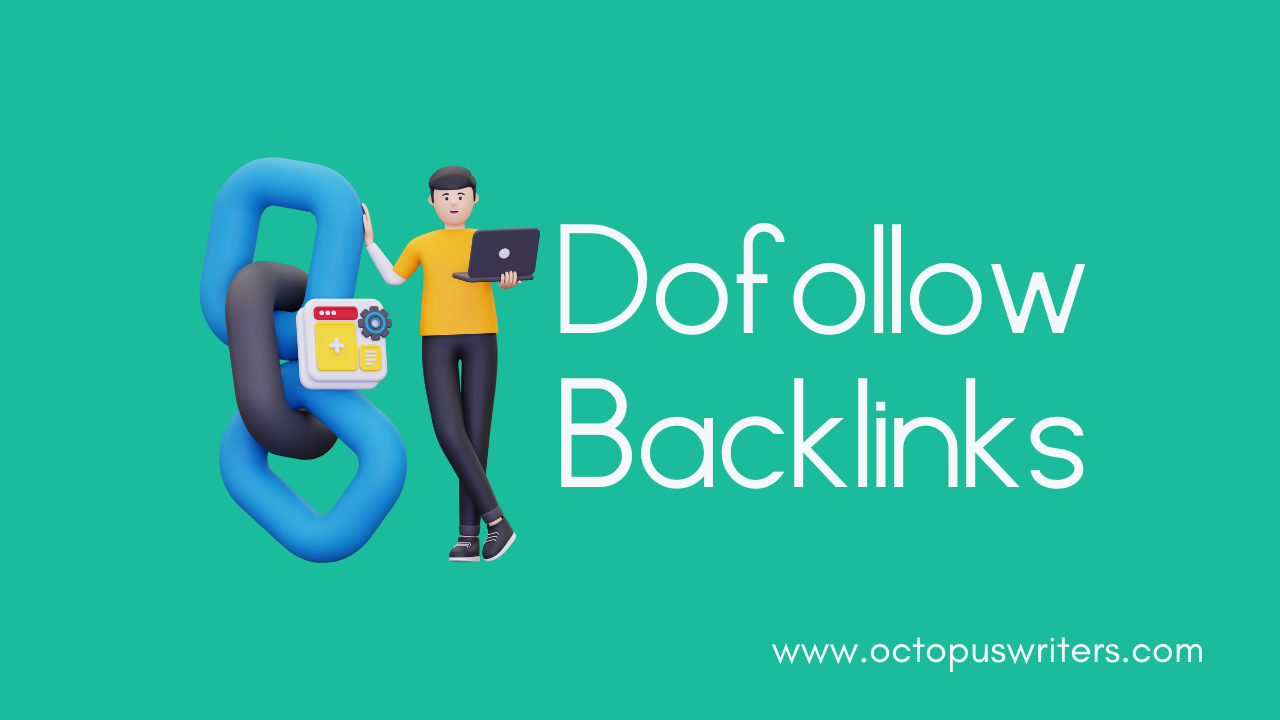You want to outrank your competitors, and for that, you need backlinks to your website. However, only dofollow backlinks contribute to SEO rankings, while nofollow links do not. That’s why it’s crucial to understand what dofollow backlinks are and how to acquire them.
In this article, OctopusWriters will explain the difference between dofollow and nofollow links. We will also show you how to check whether a link is dofollow or nofollow, and how you can obtain dofollow backlinks that pass SEO value to your site, ultimately driving search engine traffic.
What Are Dofollow Backlinks?
A dofollow backlink is a type of hyperlink that tells search engines to follow the link and transfer ranking power, often referred to as “link juice,” to the destination page. This type of link plays a crucial role in influencing the search engine rankings of the linked page, as it signals to search engines that the content being linked to is valuable and relevant.
In HTML, dofollow links are the default state and don’t need any special attributes unless they are intentionally marked as “nofollow,” which instructs search engines not to pass on ranking credit.
The Benefits of Dofollow Backlinks
Dofollow backlinks are vital for SEO since they serve as endorsements from one website to another. Unlike nofollow links, which block the flow of link equity, dofollow backlinks allow search engines to transfer value, potentially boosting a site’s PageRank, a key factor in how search engines rank web pages.
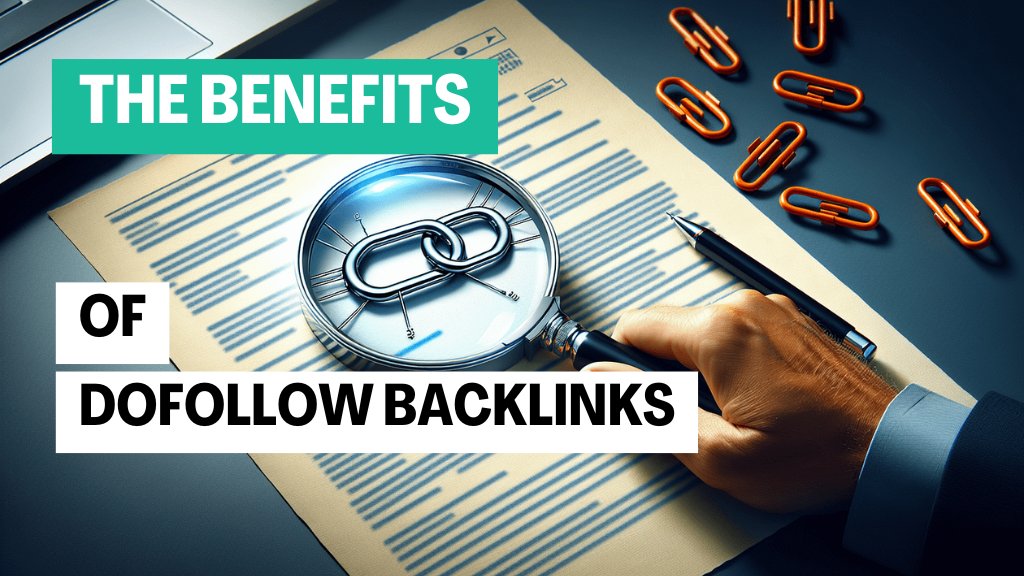
When evaluating a website for search results, search engines consider the number and quality of dofollow backlinks. These links act like votes of confidence, with one website vouching for the quality of another’s content. If a site with a strong reputation links to your page, it tells search engines that your content is reliable and valuable.
In the realm of link building, quality always outweighs quantity. Securing quality backlinks from authoritative sites can greatly enhance your ranking by increasing your domain rating. However, if your site attracts poor-quality backlinks, it can harm your SEO, dragging down your domain rating and overall performance
How To Distinguish Between High-Quality And Low-Quality Backlinks
A simple way to judge the quality of a backlink is to examine the website it’s coming from. The higher the Domain Rating (DR) of the site, the better the backlink’s quality. Low-quality backlinks typically come from sites with poor domain ratings or from spammy websites designed to harm your SEO efforts.
In short, dofollow backlinks from reputable sources can improve your SEO by:
- Increasing organic traffic from referring sites.
- Using optimized anchor text to help your keyword rankings.
- Boosting your overall Domain Rating.
The key lesson when learning how to obtain dofollow backlinks is to focus on quality. A well-executed link-building strategy that targets high DR dofollow backlinks will boost your domain rating, improve your rankings, and increase organic traffic in the long run.
What’s The Difference Between Dofollow And Nofollow Links?
In contrast to dofollow links, nofollow links generally aren’t followed by search engine crawlers and don’t typically transfer link equity from one website to another. These links are often used for paid or sponsored content, as well as user-generated content (UGC). However, it’s essential to properly label sponsored and UGC links with the appropriate rel tags, such as rel=sponsored and rel=ugc, respectively.
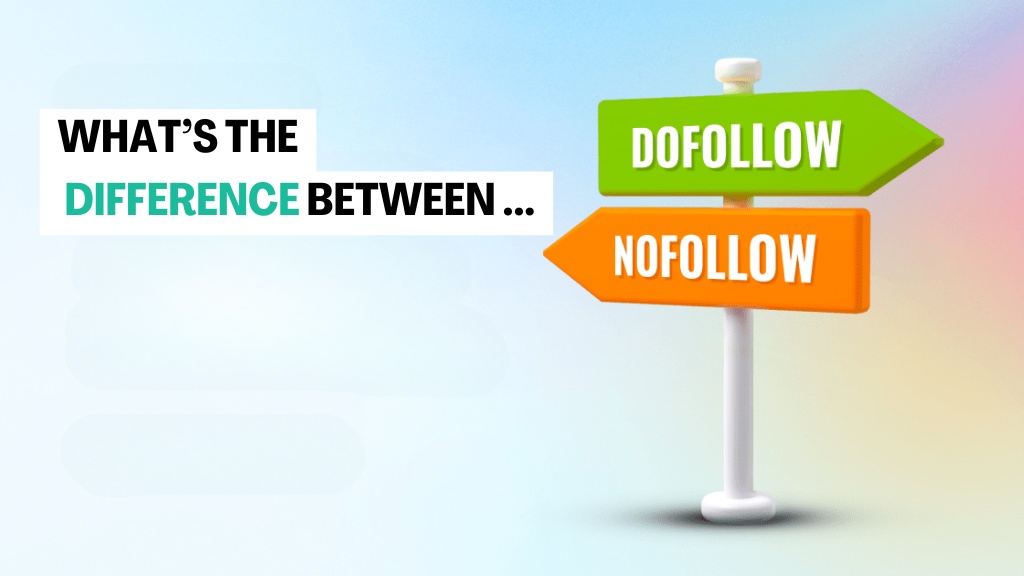
While nofollow links don’t affect the user experience (since their attributes are invisible to website visitors), they still play a role in SEO. Pages that receive nofollow links can still be indexed by search engines, although these links won’t pass any PageRank, the ranking value often referred to as “link juice.”
PageRank is a score that reflects the importance of a webpage based on the quantity and quality of its inbound links. A higher PageRank boosts a page’s visibility in search engine results. The more high-quality links pointing to a page, the more likely it is to have a high PageRank.
Dofollow links help pass PageRank from one page to another. When a site links to another using a dofollow link, it signals to search engines that the linked content is relevant and valuable, which in turn increases the linked page’s authority. In contrast, nofollow links do not transfer PageRank to the pages they point to.
Should You Provide Dofollow Links From Your Own Site?
When managing internal links (links between pages on your own website), it’s generally a good practice to keep them as dofollow links. Here’s why:
- They assist search engines in effectively crawling and indexing your site.
- Dofollow internal links help distribute PageRank and link equity throughout your website, improving your site’s overall SEO performance.
- They also help enhance the ranking of specific pages by passing value from one page to another.
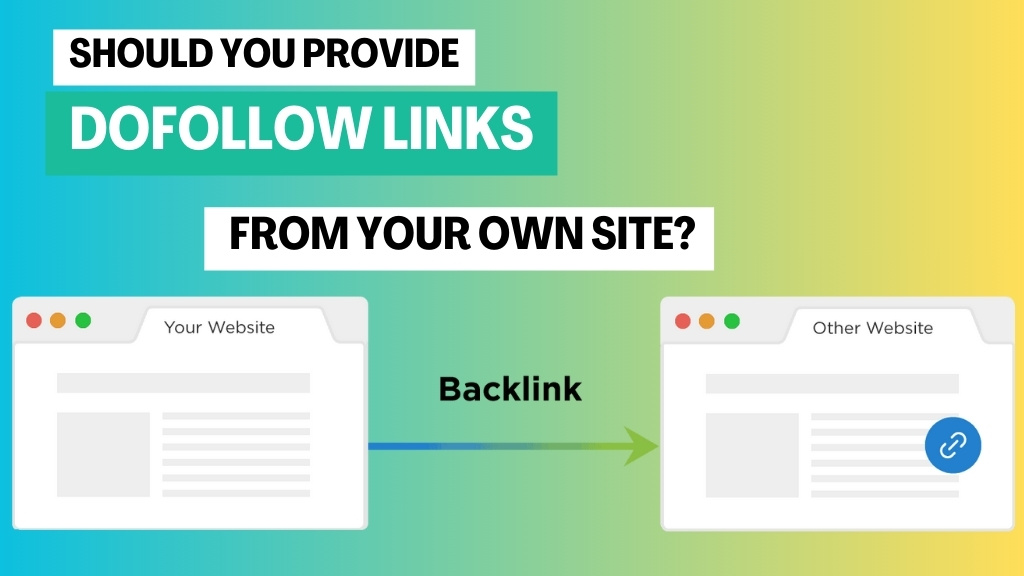
For external links (links pointing to other websites), the decision to use dofollow or nofollow depends on the situation. If you want to pass along link equity, keep the link as dofollow. If not, mark it as nofollow.
In general, linking to authoritative websites with a higher or comparable Domain Rating (DR) is perfectly fine to do with a dofollow link. However, if you’re linking to a lower-quality site or one with a lower DR, using a nofollow link may be more appropriate.
There’s no universal rule when deciding between dofollow and nofollow links for external linking, as it largely depends on whether you’re comfortable passing PageRank to the external site.
Think of your website as a container. Every inbound link adds value, much like filling the container with water. Each outbound dofollow link acts as a small hole, allowing some of that value to flow out. While linking to authoritative sources won’t harm your site, too many outbound links can slow your traffic growth.
A well-balanced external link profile should include a mix of dofollow and nofollow links for optimal SEO performance.
Dofollow Link Example
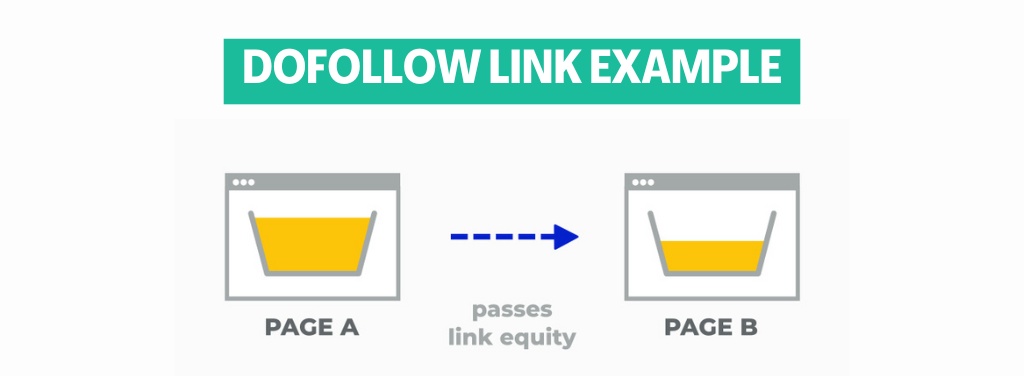
A great example of a dofollow backlink could be when a website focused on interior design links to a site that sells paints, furniture, or home décor items using a simple, standard link. This type of link would pass link equity (or “link juice”) to the furniture site, potentially boosting its visibility and ranking in search engine results.
Let’s take a look at what a dofollow link for an interior design website would look like in HTML:
<a href="https://example.com">Check out this furniture collection</a>
By default, this link serves as a dofollow backlink, meaning it allows search engines to follow the link and transfer ranking value to the linked site. However, if the link is modified to behave as a nofollow link, here’s how it would appear:
<a href="https://example.com" rel="nofollow">Check out this furniture collection</a>
In this case, the rel="nofollow" attribute instructs search engines not to pass any link juice to the destination page. The “nofollow” tag is a clear indicator that the link won’t contribute to the search ranking of the linked site. The main difference between inbound, outbound, and internal links lies in whether or not the nofollow attribute is present-links without this attribute are considered dofollow by default.
Here’s another example of a dofollow backlink in HTML:
<a href="https://example.com">Explore our latest paint colors</a>
And for comparison, here’s an example of a nofollow backlink:
<a href="https://example.com" rel="nofollow">Explore our latest paint colors</a>
As you can see, the only difference is the presence of the rel="nofollow" attribute, which prevents the link from passing SEO value.
What Are Some Dofollow Backlinks Checkers?
One effective way to enhance your overall SEO strategy is by analyzing the dofollow backlinks in your site’s backlink profile, as well as those of your competitors. By examining factors such as the ratio of dofollow vs. nofollow links, the number of new vs. lost backlinks, link-building speed, and the domain authority and page authority of incoming links, you can gain valuable insights into how your metrics stack up against other websites.
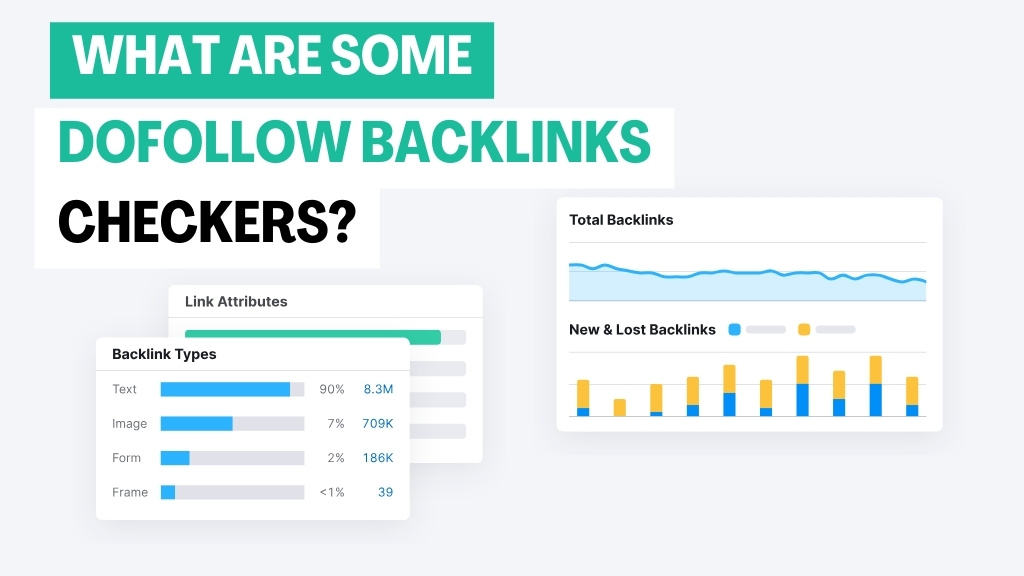
Dofollow link analysis tools offer critical data on which off-page SEO strategies are working best for your site and your competitors. This information helps you refine your approach to climb higher in search engine results. Here are some of the top tools for conducting these kinds of backlink analyses:
- Sitechecker
- LinkGraph
- Ahrefs
- SEMrush
12 Techniques For Getting Dofollow Backlinks To Your Website
To boost your site’s SEO, focus on earning dofollow backlinks. Techniques include guest posting on authoritative blogs, creating valuable content, leveraging broken links, and listing your business in directories. These strategies help increase your website’s visibility and search rankings.
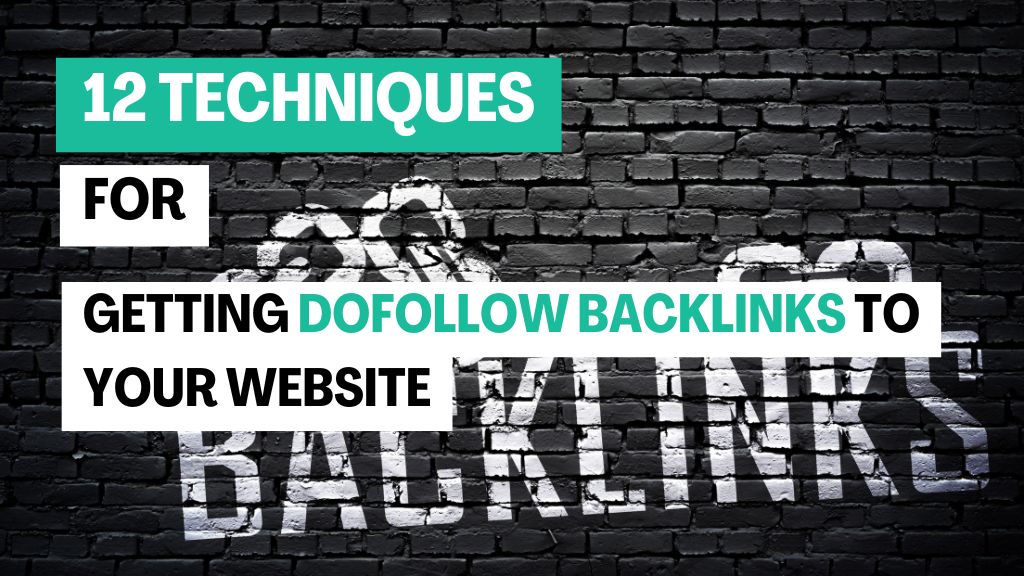
Profile Creation Or Linking
One straightforward way to earn dofollow backlinks is through profile creation on websites that allow users to build profiles. Many sites function as “link hubs,” where you can register, create a profile, and add a link to your website. By linking your site to these trustworthy profile pages, search engines like Google may view these as endorsements, helping to improve your page ranking.
However, whether this approach truly benefits your SEO depends on the quality of the site. Always aim to create profiles on high-authority, reliable websites to ensure that the backlink contributes positively to your SEO efforts.
Guest Blogging
Guest blogging is another effective technique to earn dofollow backlinks. By writing articles for other blogs, you can secure backlinks to your website in exchange for valuable content. The advantage is that you can insert your backlink naturally within the post, either in the body text or in the author bio section.
To find guest posting opportunities, try searching Google with keywords like “target keyword + write for us.” Once you find a relevant blog, review its guest blogging guidelines and reach out to the editor with your pitch. Consistent guest blogging on high-quality sites not only earns you backlinks but also helps build your authority in your niche.
Email Outreach
Email outreach is another proven method to acquire dofollow backlinks. However, the goal of outreach shouldn’t just be about obtaining links; rather, it’s about sharing value with other website owners or influencers in your field. By offering them valuable content, you increase the likelihood of earning a backlink naturally.
Start by identifying websites that produce content similar to yours. You can do this by researching the top blogs in your niche or searching for influencers who regularly share relevant content. Then, craft personalized emails to those influencers or website owners, offering them valuable resources or articles they can benefit from. If your content resonates with them, it may lead to a backlink.
The key to successful outreach is knowing who to contact. Begin by looking at influencers who have already shared or engaged with content similar to yours. You can also explore directories or use Google to identify leading blogs in your niche. Once you’ve identified potential influencers, analyze who interacts with their content-whether through social shares or comments-and use that information to guide your outreach efforts.
Link-worthy Content
One of the most effective methods to secure dofollow backlinks is by creating high-quality, link-worthy content. Your focus should be on producing material that other industry professionals and bloggers find valuable enough to reference and link to. While this strategy may be time-consuming, the long-term benefits are worth the effort. You can create various types of content such as guides, how-to articles, list posts, and interactive content like quizzes.
For instance, if you have a fashion blog, you could write a detailed article on “How to Start a Fashion Brand on a $100 Budget” or compile a list of “50 Fashion Trends Shaping the Future of Style.”
Here are some types of linkable assets that can help attract dofollow backlinks:
- Tools: Free tools provide value to users and are a great way to earn dofollow backlinks. For example, a fitness website could create a nutrition calculator to help users track their meals.
- Ultimate Guides: Comprehensive guides are often linked by other websites as a reliable resource, which can drive multiple backlinks to your site.
- Research and Studies: Data-driven articles based on research or compiled statistics are useful resources for other writers, leading to valuable backlinks.
- Visual Content: Infographics, charts, and illustrations are highly shareable. Visual content is a key aspect of SEO marketing, with 52% of marketers emphasizing its importance. By creating engaging visuals, you increase the chances of earning dofollow backlinks from other sites.
Anchor Text And Hyperlinks
Hyperlinks are the clickable links you add to specific words or phrases in your content, known as anchor text. For SEO purposes, it’s important to use relevant keywords as anchor text because search engines consider these signals when ranking content. You can include these hyperlinks within the main content or in the author bio at the end of a post.
When writing guest posts or collaborating with others, use carefully chosen anchor text that reflects the keywords you’re targeting. This will help improve the relevance of your backlinks and increase the chances of positively impacting your search engine rankings.
Social Networking
Leveraging social networks is a powerful way to build inbound links to your website. One effective method is collaborating with influencers or other content creators, similar to how YouTubers collaborate to grow their subscriber base. Websites and blogs in the same niche can work together, sharing links and boosting each other’s SEO efforts.
When you collaborate by sharing valuable content or guest posts, the backlinks created seem organic and natural to search engines. You can write guest articles for their site or simply include a relevant link to their content. This kind of collaboration enhances your link profile while benefiting both parties involved.
Use HARO To Create Dofollow Backlinks
Help A Reporter Out (HARO) is an excellent platform for building dofollow backlinks without the hassle of constant outreach. HARO connects journalists with credible sources, offering you the opportunity to gain valuable media exposure. This is an ideal solution for marketers, consultants, and bloggers looking to establish authority while building high-quality backlinks.
To get started, create a HARO account and sign up as a source. Journalists will post questions on various topics, and you can respond to those inquiries with expert information. In return, you can receive both dofollow and nofollow backlinks, helping search engines discover your site and boost its visibility. Regardless of your niche, HARO offers a great way to gain backlinks and media attention with minimal effort.
Business Listings
Business listings play a crucial role in local SEO, helping your website rank higher in local searches and improving your visibility to nearby customers. By optimizing your local SEO, you’ll not only boost your local presence but also acquire organic dofollow backlinks that enhance your website’s authority.
Here are some key strategies for improving your local SEO through business listings:
- Register on Google My Business: This free platform allows your business to appear on Google Maps and in local search results. Ensure your business information and website URL are up to date, as this will improve your credibility and attract more local traffic
- Encourage User Reviews: Positive user reviews help build trust with potential customers and enhance your SEO profile. Encourage satisfied customers to leave reviews, as these can improve your online reputation and visibility.
- Create Location Pages: If your business operates in multiple locations, it’s essential to create dedicated location pages on your website. These pages should include details like your business name, address, phone number, operating hours, and a description of the services offered at each location. Additionally, mention parking and transportation options to make it easier for local customers to find you.
By implementing these strategies, you’ll not only improve your local SEO but also naturally attract high-quality backlinks, which can strengthen your website’s domain authority.
Write Testimonials
Did you know that writing testimonials for businesses or products you use can earn you a dofollow backlink? Many companies feature customer reviews on their websites, often on the homepage, as part of their social proof strategy. If you regularly use a tool, product, or service relevant to your niche, offer to provide a testimonial in exchange for a dofollow backlink.
Look for businesses that align with your industry and make sure they have a high Domain Authority (DA). Backlinks from high-DA websites are considered high-quality by search engines, giving your SEO a significant boost.
Find Backlinks You Can Replicate
One powerful strategy for gaining dofollow backlinks is to replicate your competitors’ backlinks. By studying your competitors’ backlink profiles, you can identify the most valuable dofollow backlinks they have and recreate them for your own website. While this process may take some time, the results can be incredibly rewarding.
The goal here is to use the same link-building tactics your competitors are using. Once you’ve identified a referring domain where your competitor has gained a backlink, check how they obtained it. Did they leave a comment on a blog? Did they contribute a guest post? Whatever method they used, you can apply it to secure a backlink from the same site.
For instance, you can leave a thoughtful comment in the comment section of the same blog post, or if it’s a forum, join the conversation. However, be cautious and avoid getting backlinks from low-quality or spammy sites, as they can harm your SEO efforts.
Look For Broken Links
Acquiring high-quality backlinks is only half the battle; maintaining them is just as crucial. Backlinks can break for various reasons, and it’s important to identify and fix these broken links to preserve your SEO value. Here are some common causes:
- Google Updates: Major Google algorithm updates often reshape the SEO landscape, causing changes in keyword rankings. As a result, some URLs may become outdated or irrelevant, leading to broken links. Conducting a regular lost link audit can help you spot and fix any broken links caused by such updates, ensuring that you retain the SEO value from your critical pages.
- Rebranding: When a company rebrands, it often involves changing domain names or URLs to reflect the new identity. This transition can result in old links pointing to now-defunct URLs, leading to 404 errors. Keeping track of your backlinks during rebranding and updating them to reflect the new URLs can prevent the loss of valuable link equity.
- Deleted Pages: Another common cause of broken links is when a website deletes a page that used to host your backlink. If this happens, you’re left with a broken link. Keeping an eye on such deleted or 404 pages gives you the chance to request updated links to relevant content on your site.
You can also turn broken links into an opportunity by identifying outdated resources and replacing them with your own updated content. Here’s how to do it:
- Find Outdated Content in Your Niche: Look for sites that have either rebranded, moved URLs, stopped offering a particular service, or no longer update a valuable resource. Some websites may have even shut down entirely.
- Identify Broken Links: Use a backlink-checking tool to identify which websites are still linking to those outdated URLs.
- Reach Out to Webmasters: Once you’ve identified these broken links, contact the site owners. Let them know that the link is no longer valid and suggest that they replace it with a link to your updated, relevant content. Be polite and emphasize the value your resource will bring to their site.
By focusing on sites with high Domain Authority, you increase the chances of gaining valuable dofollow backlinks while offering helpful content in return.
Add Your Website To Resource Pages
Resource pages are webpages that compile helpful links to tools, articles, and services, making them a great source for gaining dofollow backlinks. To get your website listed on these resource pages, simply reach out to the site owner or editor and request to be included.
To find relevant resource pages, search for keywords in your niche along with terms like “resource list” or “useful resources.” Once you’ve identified a few good pages, contact the webmasters via email and suggest adding your website to their list.
When reaching out, be sure to personalize your email, explain why your website would benefit their readers, and highlight how it complements their resource page. A tailored approach increases your chances of being added to the list and gaining a high-quality backlink.
Should You Buy Dofollow Backlinks For SEO In 2024?
Buying backlinks involves paying another website to place a link that points back to your own. The primary reason people purchase backlinks is to improve their site’s search engine rankings on platforms like Google and Bing. Other motivations might include driving more referral traffic or boosting conversions, although these are less common goals.
So, do people really buy backlinks?
Yes, they do!
High-quality backlinks from websites with strong domain authority are extremely valuable. This is because the number and quality of backlinks pointing to a site is one of the most critical ranking factors for search engines, particularly Google. The more relevant, high-quality backlinks you have, the better your chances of ranking well in the SERPs (search engine results pages).
However, there’s a catch. While Google does consider backlinks in its ranking algorithm, it doesn’t want paid links to influence rankings unfairly. In fact, trying to hide purchased backlinks from Google is risky business.
In simple terms, using paid links without disclosing them is like launching a shaky, unpredictable rocket. If you’re fortunate, the rocket might boost your rankings sky-high. But more likely, it will crash and burn, dragging down your SEO efforts and your rankings with it.
Mistakes To Avoid
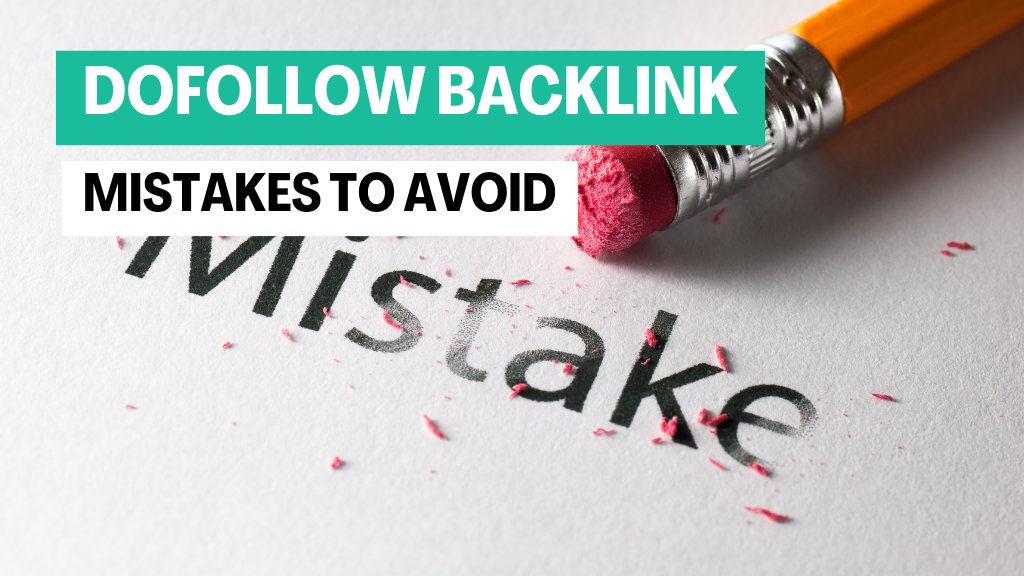
When working with dofollow backlinks, it’s essential to avoid certain pitfalls that could negatively impact your SEO. Here are a few common mistakes:
- Overusing Dofollow Links: While dofollow backlinks are important for boosting your SEO, relying exclusively on them can raise a red flag with Google. It’s crucial to maintain a natural link profile, which includes a healthy mix of both dofollow and nofollow links. Overloading your backlink profile with only dofollow links may seem suspicious and could result in penalties. A balanced strategy mimics organic linking patterns and ensures long-term SEO success.
- Allowing Dofollow Links in Comments: One major mistake to avoid is allowing dofollow links in the comment section of your website. This practice opens the door for spammy or irrelevant links, which can pollute your site’s comment space and harm your SEO. When spammers flood your comments with links to low-quality or unrelated sites, it can damage your credibility and harm your netlinking strategy. Always use nofollow tags for comments to prevent unwanted backlinks from influencing your site’s SEO.
- Focusing Only on Quantity Over Quality: A common misconception in link-building is that more backlinks are always better. However, quality trumps quantity when it comes to building an effective backlink profile. Prioritize acquiring dofollow backlinks from authoritative, trustworthy sites in your niche. A few high-quality links from reputable sites are far more valuable than a large number of low-quality links from irrelevant or spammy websites.
- Ignoring Anchor Text Diversity: Using the same anchor text for every backlink is another mistake to avoid. Search engines prefer natural variation in anchor text, and over-optimization can lead to penalties. Diversify your anchor text by including branded terms, partial keywords, and even generic phrases to ensure that your link profile appears more organic and less manipulative.
- Linking from Irrelevant Sources: Building backlinks from irrelevant websites or pages unrelated to your niche can do more harm than good. Google values context, and backlinks from sites that are closely aligned with your industry or content theme carry much more weight. Always ensure that your backlinks come from websites or blogs that share a relevant connection to your field. This helps boost your credibility and ensures that the links are seen as genuine endorsements.
By avoiding these mistakes and focusing on a balanced, high-quality link-building strategy, you can maximize the SEO benefits of dofollow backlinks and avoid the risk of penalties or poor rankings.
Dofollow Backlinks – Frequently Asked Questions
What Is A Dofollow Link? |
| A dofollow link is a type of hyperlink that allows search engines to follow it and pass SEO value (or “link juice”) to the linked webpage, helping improve its search engine ranking. |
How To Check If A Link Is Dofollow Or Nofollow? |
To check if a link is dofollow or nofollow, inspect the HTML code of the page. If the link has the attribute rel="nofollow", it’s a nofollow link. If this attribute is missing, it’s a dofollow link by default. |
Should I Dofollow An External Link? |
| You should dofollow external links if you’re linking to trusted, high-authority sites. This passes SEO value to those sites and signals to search engines that the content is relevant and valuable. |
How Can I Get High-Quality Dofollow Backlinks? |
| To acquire high-quality dofollow backlinks, focus on getting links from reputable, niche-specific sources. You can achieve this by contributing guest posts to authoritative blogs, listing your business in local directories, and collaborating with relevant industry websites. These tactics not only boost your website’s SEO but also enhance its online visibility and authority. |
Conclusion
As OctopusWriters has explained in detail about dofollow backlinks, obtaining dofollow backlinks requires time, effort, expertise, and often some financial investment. With such a high level of effort and expense, it’s important to ensure you’re approaching link building the right way. Without the right strategy, you could easily invest a lot of time and money, only to find that your efforts don’t improve your rankings or traffic-and may even harm your site.
While nofollow links can still be beneficial for driving referral traffic, your primary focus should be on obtaining dofollow backlinks if your goal is to increase search engine traffic.

